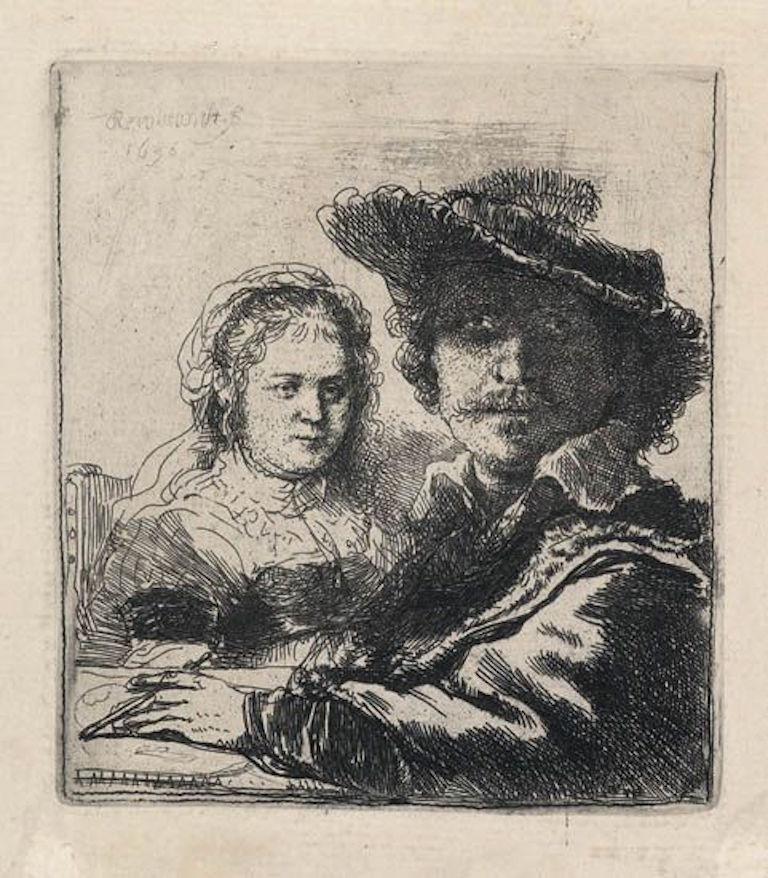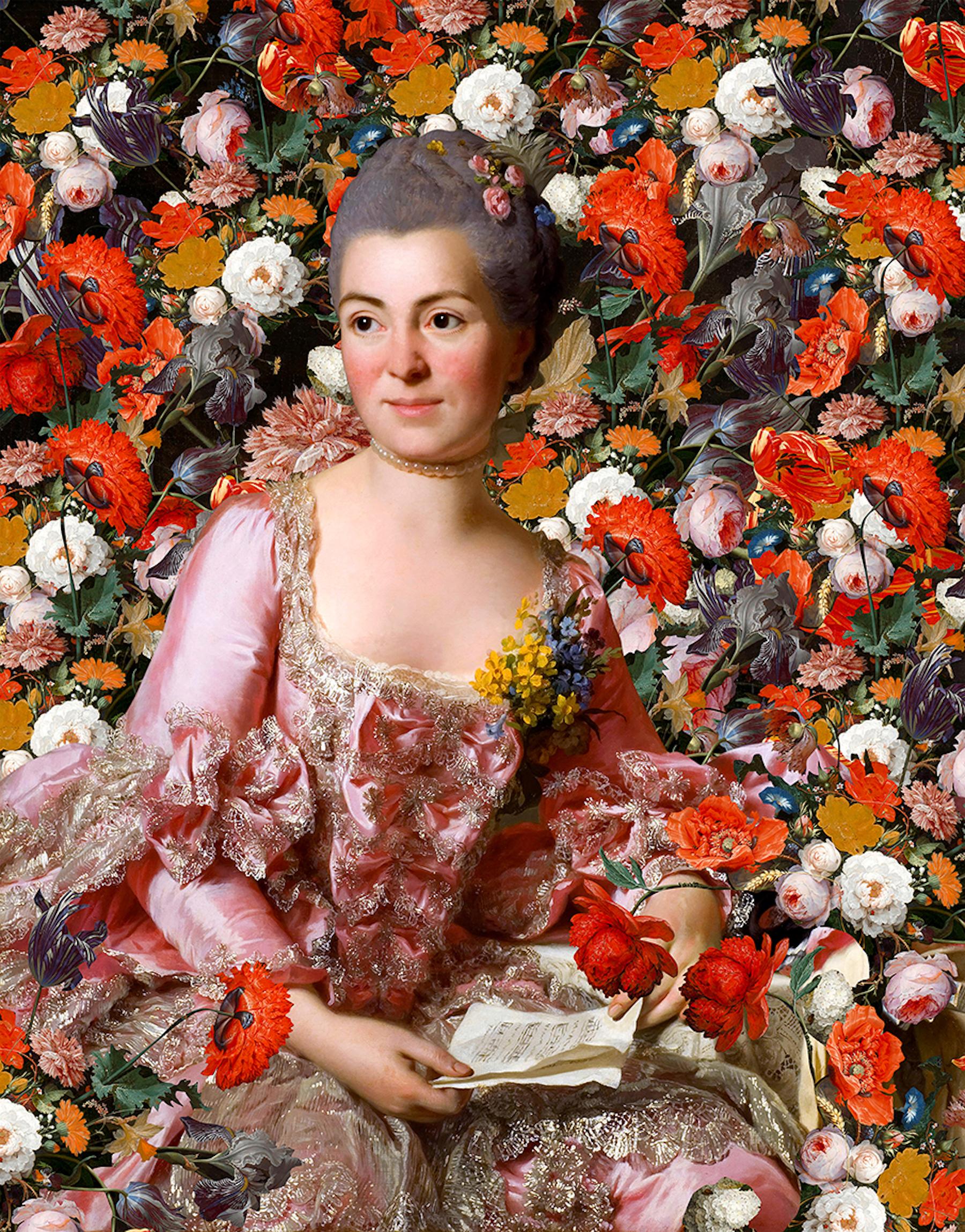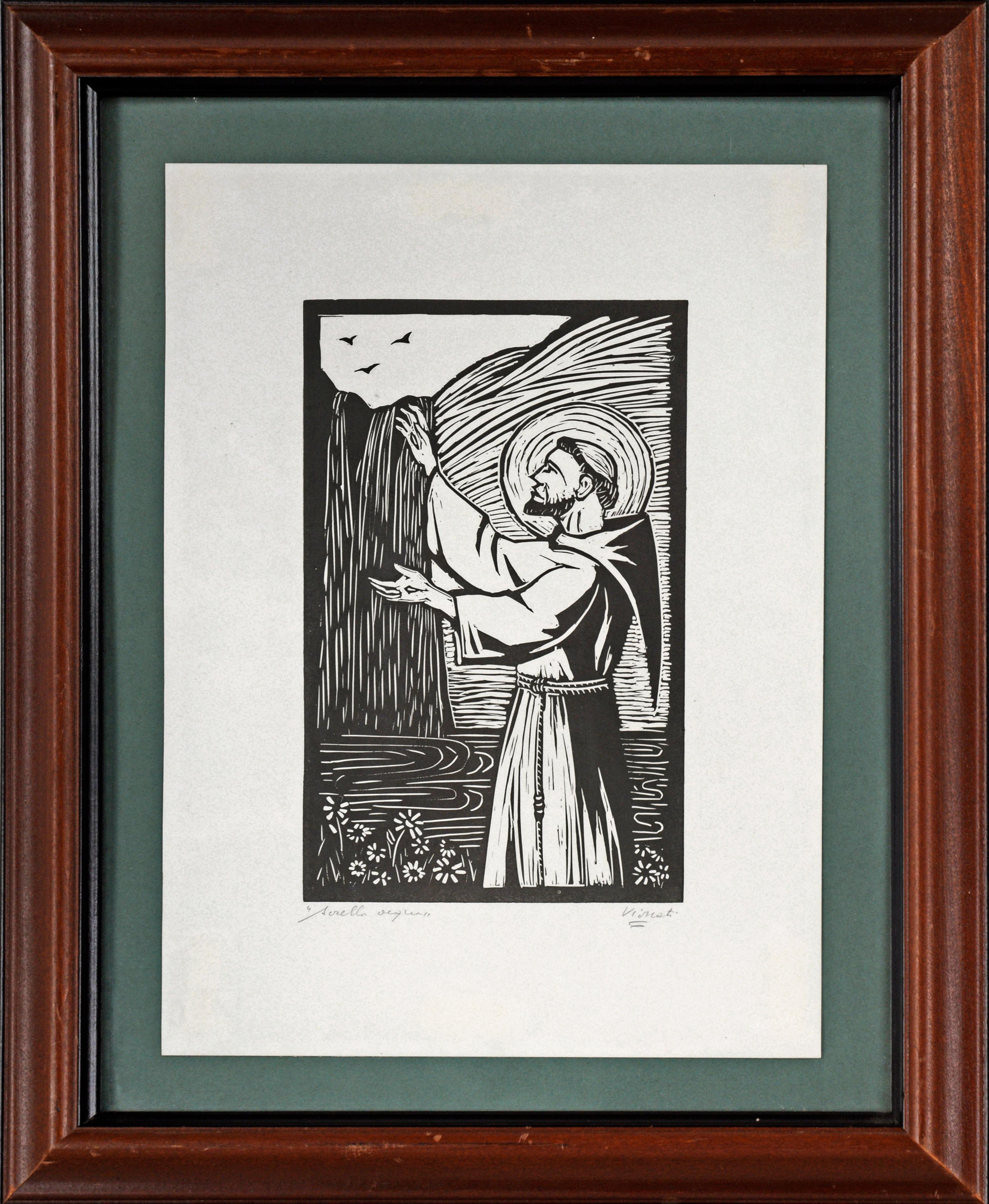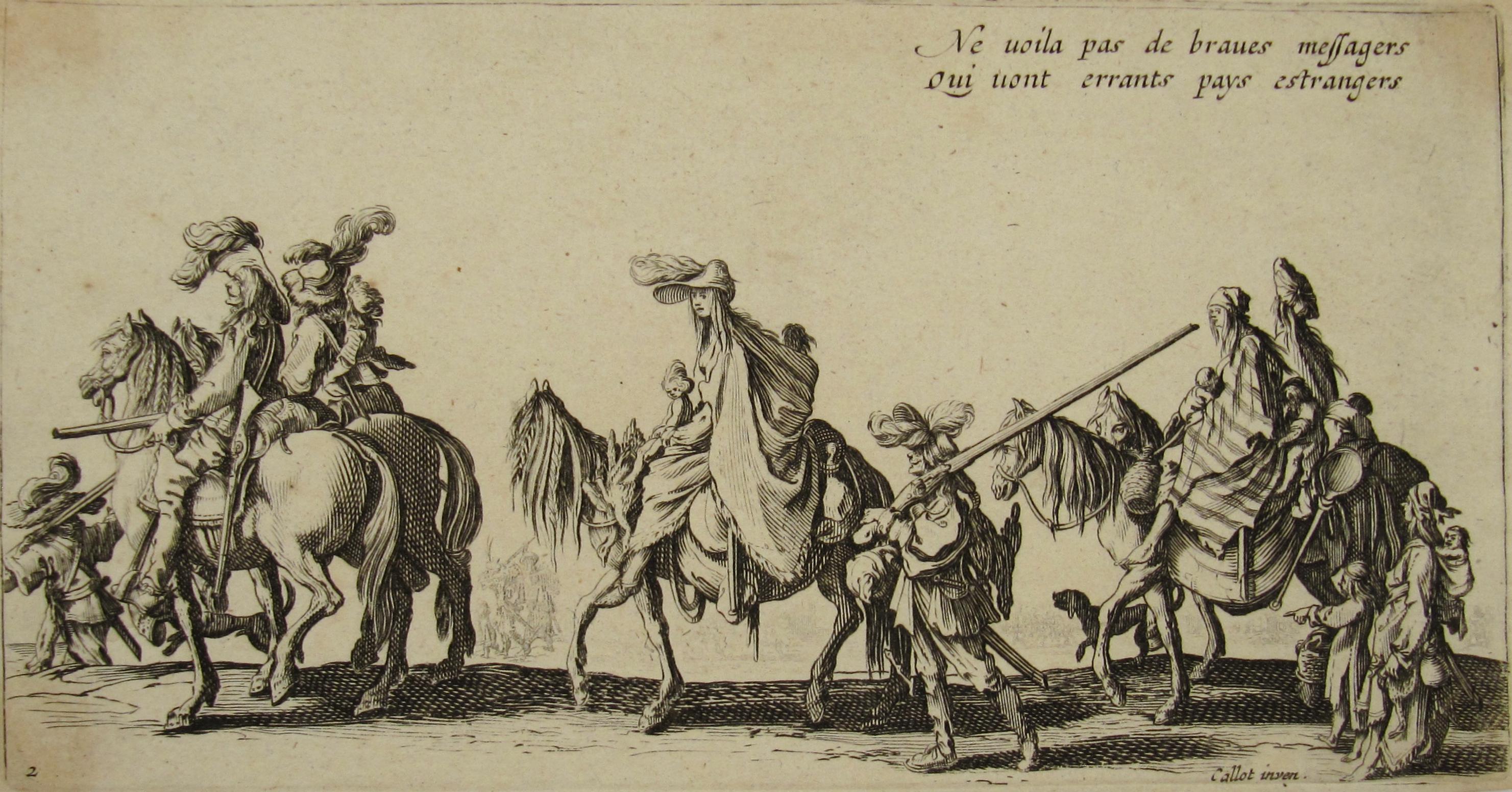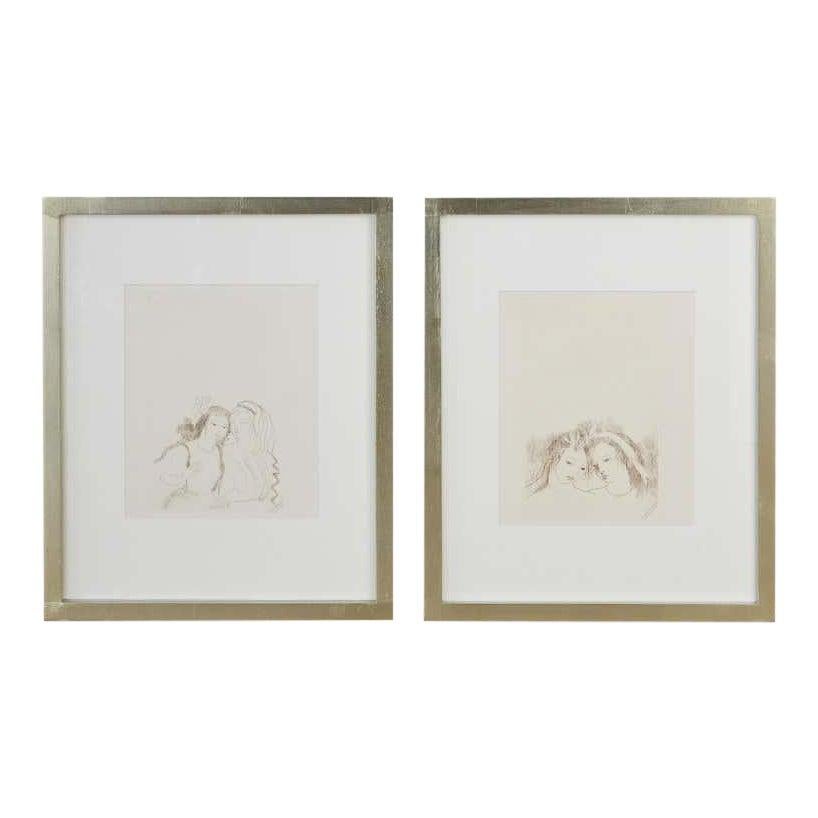Items Similar to Half-length portrait of a man with beard - A Rembrandt of the 18th century -
Want more images or videos?
Request additional images or videos from the seller
1 of 8
Johann Friedrich BauseHalf-length portrait of a man with beard - A Rembrandt of the 18th century - 1782
1782
About the Item
Johann Friedrich Bause (1738 Halle a. d. Saale - 1814 Weimar). Half-length portrait of a man with beard and cap after a drawing by Christian Wilhelm Ernst Dietrich. Etching and copper engraving, 20,4 x 16,7 cm (plate size), 37,5 x 27,8 cm (paper size), inscribed at lower left "C. W. E. Dietrich del.", signed and dated at lower right "J. F. Bause fec 1782".
Keil, no. 24. II. Brown tonal print with broad margins. Plate edge partly slightly browned and dusty in the wide margin.
- A Rembrandt of the 18th century -
About the artwork
The sitter, in the manner of Rembrandt, gazes out at the viewer with a penetrating gaze and yet, despite this sharpness, is given a painterly fluidity that contributes decisively to the attractive aura of this picture. The first version of the print, dating from 1777, was a pure etching. Bause's mastery of this technique, as well as of engraving, enabled him to create the finest nuances of light and shadow, as is particularly evident in the backlit strands of hair on the right side of the head. In 1782, after five years, Bause returned to the painting, which was unusual for the busy artist, and therefore this work has a special significance for Bause's artistic self-conception, especially as it was not a commissioned work. In the second attempt, Bause reworked the plate with a chisel, resulting in a more precise etching and a more concise depiction, culminating in the gaze. At the same time, however, the newly acquired sharpness is charged with atmosphere by the warm brown tone now used, to which the free hatchings, almost completely detached from the subject, also contribute, superimposing the coat on the collar, which has been made more precise with the graver.
The reworking that has taken place makes it clear that the graphic reproduction - in this case of a drawing by Dietrich - has not been conceived as the most meticulous possible copy, which is not even possible because of the medial leap from drawing or oil painting to graphic art, but as a new creation, which at the same time represents an interpretation of the reproduced work. Graphic reproduction is thus a creative art of interpretation, which is here sharpened to Bause's artistic self-conception. Georg Keil reports that Bause - like the sitter - had beautiful long hair, which he had styled every day. Whatever truth there may be in this anecdote, its true essence lies in the fact that Bause here shows himself as an artist refracted through the template of the drawing, which is reinforced by the fact that Dietrich's drawing refers to the self-portraits so central to Rembrandt's oeuvre.
"As a portrait engraver he [i.e. Bause] belongs to the most excellent masters. [...] The freedom and certainty of the painter are undiminished in his engraved portraits. The parts of the flesh are exquisitely treated with infinite delicacy and softness, and every substance is faithfully and truly expressed in its character".
About the artist
Johann Friedrich Bause was orphaned at an early age and trained himself as an artist, making him one of the great self-taught artists of the 18th century, along with Daniel Nikolaus Chodowiecki. Initially Bause engraved book decorations for booksellers in Halle, but in 1759 he went to Augsburg for a year to study the mezzotint technique under Johann Jacob Haid. In Augsburg he became friends with Anton Graff, who was about his age and who painted portraits of Bause in Augsburg. Later, during Bause's time in Leipzig, Graff stayed with Bause, who would engrave a total of 45 of his portraits, while Graff in turn portrayed Bause several times.
Back in Halle from Augsburg, Bause began to produce prints, preferring drawings by Georg Friedrich Wille, a Parisian artist whom he greatly admired. In 1766 he dedicated the print Die fleißige Hausfrau after Gerard Dou (Keil, 35) to Wille. Wille recognised Bause's talent and contacted him, which led to a correspondence that lasted until Wille's death in 1808.
In 1766 Bause was appointed by Adam Friedrich Oeser to teach copper engraving at the newly founded Leipzig Academy of Arts. In Leipzig Bause had a printing press installed in his house to keep the quality of the engravings at the highest level.
In 1786 Bause became an honorary member of the Prussian Academy and in 1796 of the Stockholm Academy. In 1809, with failing eyesight, he made his last engraving, a portrait of his son-in-law. In 1813, due to the French occupation, he left the city with his wife and widowed daughter and moved to Weimar, where he died soon after.
The artist's work, which fell into oblivion at the end of the 19th century, is gradually being rediscovered, as shown by the recent monographic exhibitions in Leipzig and Luxembourg.
Selected bibliography
Georg Keil: Catalog des Kupferstichwerkes von Johann Friedrich Bause, Leipzig 1849.
Nicole Linke: Johann Friedrich Bause. Ein heute kaum bekannter hallescher Kupferstecher des 18. Jahrhunderts. In: Von Nutzen und Vergnügen. Aus dem Kupferstichkabinett der Universität Halle, hrsg. v. Ralf-Torsten Speler, Halle 1999.
Stephan Brakensiek (Hrsg.): Leipziger Allerlei – Johann Friedrich Bause (1738–1814) und der Porträtstich im 18. Jahrhundert, Trier 2014.
GERMAN VERSION
Johann Friedrich Bause (1738 Halle a. d. Saale - 1814 Weimar). Brustbild eines Mannes mit Knebelbart und Mütze nach einer Zeichnung von Christian Wilhelm Ernst Dietrich. Radierung und Kupferstich, 20,4 x 16,7 cm (Plattenmaß), 37,5 x 27,8 cm (Papiermaß), links unten bezeichnet „C. W. E. Dietrich del.“, rechts unten signiert und datiert „J. F. Bause fec 1782“.
Keil, Nr. 24. II. Zustand in brauntonalem Abzug mit breitem Rand. Plattenkante teilweise leicht gebräunt und im breiten Rand angestaubt.
- Ein Rembrandt des 18. Jahrhunderts -
zum Kunstwerk
Die in rembrandtscher Manier dargestellte Person blickt den Betrachter durchdringend an und ist - trotz dieser Schärfe - doch in einem malerischen Fluidum gegeben, das entscheidend zur anziehenden Aura dieses Bildes beiträgt. Die aus dem Jahre 1777 datierende erste Version der Grafik war eine reine Radierung. Diese Technik beherrschte Bause ebenso virtuos wie den Kupferstich, so dass es ihm gelang, feinste Licht-Schatten-Nuancierungen zu erzeugen, wie sie insbesondere bei den auf der rechten Seite hinterleuchteten Strähnen der fülligen Haarpracht vor Augen stehen. Nach fünf Jahren wandte sich Bause 1782 erneut dem Bild zu, was für den vielbeschäftigen Künstler eine Besonderheit darstellt, weshalb diesem Werk für Bauses künstlerisches Selbstverständnis eine besondere Relevanz zukommt, zumal das Bild nicht als Auftragsarbeit entstanden ist. Im zweiten Anlauf überarbeitete Bause die Platte mit dem Grabstichel, was zu einer Präzisierung der Radierung führte, aus der die im Blick kulminierende Prägnanz der Darstellung resultiert. Zugleich wird die neu gewonnene Schärfe aber durch den nun verwendeten warmen Braunton erneut atmosphärisch aufgeladen, wozu auch die beinahe gänzlich vom dargestellten Gegenstand gelösten freien Schraffuren beitragen, die den mit dem Grabstickel präzisierten Mantel am Kragen überlagern.
Die erfolgte Überarbeitung verdeutlicht, dass die druckgrafische Reproduktion - in diesem Fall einer Zeichnung von Dietrich - nicht als möglichst akribische Kopie aufgefasst worden ist, was aufgrund des medialen Sprungs von der Zeichnung oder dem Ölbild in die Grafik auch gar nicht möglich ist, sondern als eine Neuschöpfung verstanden worden ist, die zugleich eine Interpretation des re-produzierten Werks darstellt. Die druckgrafische Reproduktion ist mithin eine schöpferische Kunst der Interpretation, die hier auf das künstlerische Selbstverständnis Bauses zugespitzt ist. Georg Keil berichtet, dass Bause - wie die dargestellte Person - schönes langes Haar gehabt hätte, das er jeden Tag frisieren zu lassen pflegte. Was an dieser Anekdote auch immer Wahres sein mag, liegt ihr wahrer Kern darin, dass sich Bause hier durch die Vorlage der Zeichnung gebrochen selbst als Künstler zeigt, was noch zusätzlich bestärkt wird, indem sich Dietrichs Zeichnung auf die in Rembrandts Oeuvre so zentralen Selbstbildnisse bezieht.
„Als Portraitstecher gehört er [d.i. Bause] zu den ausgezeichnetsten Meistern. [...] Die Freiheit und Sicherheit des Malers findet man ungeschmälert in seinen gestochenen Bildnissen wieder. Die Fleischpartien sind vortrefflich und mit unendlicher Zartheit und Weichheit behandelt, und jeder Stoff ist in seinem Charakter treu und wahr ausgedrückt.“
Georg Keil
zum Künstler
Der früh verwaiste Johann Friedrich Bause bildete sich im Selbststudium zum Künstler aus und gehört damit - wie Daniel Nikolaus Chodowiecki - zu den großen Autodidakten des 18. Jahrhunderts. Stach er zunächst Buchschmuck für Hallenser Buchhändler, ging Bause 1759 für ein Jahr nach Augsburg, um sich dort unter der Leitung von Johann Jacob Haid weiterzubilden und die Schabkunstmanier zu erlernen. In Augsburg schloss er mit dem etwa gleichaltrigen Anton Graff Freundschaft, der Bause in Augsburg porträtierte. Später, in Bauses Leipziger Zeit, logierte Graff bei Bause, der insgesamt 45 seiner Porträts stechen sollte, während Graff Bause seinerseits noch mehrfach porträtierte.
Von Augsburg zurück in Halle begann Bause Zeichnungen druckgrafisch umzusetzen, wobei er Zeichnungen des von ihm überaus geschätzten, in Paris ansässigen Georg Friedrich Wille bevorzugte. 1766 widmet er Wille das Blatt Die fleißige Hausfrau nach Gerard Dou (Keil, 35). Wille erkannte das Talent Bauses und trat mit ihm in Kontakt, woraus sich eine bis zu Willes Tod, im Jahre 1808, währende Brieffreundschaft entspann.
1766 wurde Bause von Adam Friedrich Oeser als Lehrer für Kupferstich an die neu gegründete Leipziger Zeichenakademie berufen. In Leipzig ließ sich Bause in seinem Haus eine Druckpresse installieren, um die Druckqualität der Stiche auf höchstem Niveau zu halten.
1786 wurde Bause Ehrenmitglied der preußischen Akademie, 1796 derjenigen von Stockholm. Mit nachlassendem Augenlicht fertigte er 1809 seinen letzten Stich, das Porträt seines Schwiegersohn, an. 1813 verließ er aufgrund der französischen Besatzung mit seiner Frau und seiner verwitweten Tochter die Stadt und übersiedelte nach Weimar, wo er bald darauf starb.
Das Oeuvre des im späten 19. Jahrhundert in Vergessenheit geratenen Künstler erfreut sich einer allmählichen Wiederentdeckung, wovon die jüngste in Leipzig und Luxemburg gezeigte monographische Ausstellung zeugt.
Auswahlbibliographie
Georg Keil: Catalog des Kupferstichwerkes von Johann Friedrich Bause, Leipzig 1849.
Nicole Linke: Johann Friedrich Bause. Ein heute kaum bekannter hallescher Kupferstecher des 18. Jahrhunderts. In: Von Nutzen und Vergnügen. Aus dem Kupferstichkabinett der Universität Halle, hrsg. v. Ralf-Torsten Speler, Halle 1999.
Stephan Brakensiek (Hrsg.): Leipziger Allerlei – Johann Friedrich Bause (1738–1814) und der Porträtstich im 18. Jahrhundert, Trier 2014.
- Creator:Johann Friedrich Bause (1738 - 1814)
- Creation Year:1782
- Dimensions:Height: 14.97 in (38 cm)Width: 11.03 in (28 cm)Depth: 0.4 in (1 cm)
- Medium:
- Movement & Style:
- Period:1780-1789
- Condition:
- Gallery Location:Berlin, DE
- Reference Number:1stDibs: LU2438212379392

About the Seller
5.0
Vetted Seller
These experienced sellers undergo a comprehensive evaluation by our team of in-house experts.
Established in 2014
1stDibs seller since 2023
7 sales on 1stDibs
Typical response time: 7 hours
- ShippingRetrieving quote...Ships From: Berlin, Germany
- Return PolicyA return for this item may be initiated within 14 days of delivery.
More From This SellerView All
- Balaclava - The target in sight -Located in Berlin, DEHeinrich Haberl (1869 Passau to 1934 Munich), Sturmhaube, c. 1900. drypoint, 14 x 10 cm (platemark), 28 x 21 cm (sheet size), 39 x 29 cm (passe-partout), titled "Sturmhaube" in lead at lower left and inscribed "Kaltnadelradierung", signed and locally inscribed "Heinrich Haberl Mchn. [Munich]" at lower right, inscribed again in lead on verso and with old collection stamp. - slightly darkened, fixed and mounted - The target in sight - About the artwork The theatrical "role-portrait" is to be seen against the background of the Rembrandt cult, which reached its climax at the end of the 19th century. The soldier seems to have stepped straight out of Rembrandt's Night Watch (1642) to fix something outside the picture with an alert and ready gaze. The steeply rising brim of the morion frames the gaze and thus perspectivises it as the actual 'pictorial action'. The gaze represents both the vigilant defence and the visionary goal of the battle. Not only the subject, but also the style of the etching needle reflect Rembrandt's understanding of the times. Strong contrasts of light and dark are created in a virtuoso free stroke, without losing the effect of the reflections on the helmet and in the eyes. This shows a kinship with the early prints of Lovis Corinth, who also saw himself as an artist in the role of the knight. Against this background, Haberl's picture can also be seen as a representation of his artistic self-image. About the artist Heinrich Haberl first attended the art school in Nuremberg and from 1892 studied at the Munich Academy. There he was a master student of Johann Leonhard von Raab, Rudolf von Seitz, Franz von Defregger...Category
Early 19th Century Realist Figurative Prints
MaterialsEtching
- General Wilhelm von Blume - Visionary retrospective -Located in Berlin, DEBernhard Pankok (1872 Münster - 1943 Baierbrunn), General Wilhelm von Blume, 1915, aquatint etching, 34 x 29.5 cm (sheet size), 26 x 22 cm (plate size), signed in the plate at upper left, in pencil at lower right and dated in pencil at lower left. - At lower left old collection stamp, at the right broad margin with a small spot, otherwise very good condition. About the artwork The 1915 aquatint etching of General Wilhelm von Blume is based on a 1912 oil painting in the LWL-Museum für Kunst und Kultur in Münster. A second oil portrait of the general by Pankok is in the Staatsgalerie Stuttgart. When Pankok painted the first oil portrait in 1912, the general had already been retired for 16 years. It is therefore a retrospective portrait. Accordingly, the orientation of his head is such that he is looking back in both the oil painting and the etching. Without fixing on anything in particular, he looks thoughtfully inwards and reflects on his life. Uniformed and highly endowed, it is his military activities in particular that he is reviewing attentively and, as his gaze reveals, quite critically. Pankok has literally written the sum of his experiences on Wilhelm von Blume's face: The physiognomy is a veritable landscape of folds, furrows, ridges and gullies, all the more striking against the flat background. It is clear that each of the medals was also won through suffering. However, by breaking the boundaries of the picture, his bust appears as an unshakable massif, which gives the general a stoic quality. The fact that the design of the portrait was important to Pankok can be seen from the different versions, the present sheet being the third and probably final revision, which Pankok dates precisely to 18 February 1915. Compared with the previous state, the light background now has a dark area against which the sitter's face stands out, the dark background in turn combining with the uniform to create a new tension in the picture. Pankok's taking up of the portrait of the high-ranking military veteran and its graphic reproduction can also be seen in relation to the First World War, which had broken out in the meantime. In the face of modern weapons of mass destruction, Wilhelm von Blume's warfare and military writings were relics of a bygone, more value-oriented era. About the artist After studying at the Düsseldorf Art Academy from 1889 to 1891 under Heinrich Lauenstein, Adolf Schill, Hugo Crola, and Peter Janssen the Elder, Bernhard Pankok went to Munich in 1892, where he worked primarily as a graphic artist for the two major Jugendstil magazines "Pan" and "Jugend," which established his artistic success. Through this work he met Emil Orlik, with whom he had a lifelong friendship. In 1897, he exhibited his first furniture, and in 1898, together with Richard Riemerschmid, Bruno Paul and Hermann Obrist...Category
1910s Realist Portrait Prints
MaterialsEtching
- The Lost TraceBy Ernst FuchsLocated in Berlin, DEErnst Fuchs (1930 Vienna - 2015 ibid), The Lost Trace, 1972. Vernis mou and aquatint etching, 46.8 x 36.4 cm (plate), 66 x 50 cm (sheet), 69.5 x 53.5 cm (frame), WVZ Hartmann no. 185...Category
1970s Surrealist Figurative Prints
MaterialsEtching
- The Talisman (so called Dukatenscheisser) - The philosopher's stone -By Carl PlückebaumLocated in Berlin, DECarl Maria Plückebaum (1880 Düsseldorf - 1952 ibid.), Der Talismann (sog. Dukatenscheisser), partly colored etching, 11.5 x 8.5 cm (plate size), 26.5 x 20 cm (sheet size), signed by hand below the image on the right "C. Plückebaum" and inscribed by hand at lower left "Der Talismann". - left and right side of the sheet with browned stripes, otherwise good copy - The philosopher's stone - About the artist Here, Carl Plückebaum gives free rein to his anti-academic impulses and turns the subtle humor of his pictures into crudeness. Following Adrian Ostade's peasants as they go about their needy business, we see a cowardly fellow in a squatting position. His excrement, however, is not the organic remains of digestion, but - like the golden donkey in the Grimm fairy tale - ducats. However, they appear more brown than golden, which is emphasized by the discreet hand-coloring of the picture. The unattractive accumulation is countered by the blossoms decorating the crouching man's hat. Totally absorbed in his action, his activity is evident in the strained expression on his face, giving Plückebaum a whole new verisimilitude to the concept of naturalism. The title "The Talisman" then turns naturalism back to the miraculous, formulating in a humorous way that these legacies are also a "miracle of nature". About the artist Coming from a poor background, Carl Plückebaum, who had a walking disability and was of short stature, initially worked as a church restorer. He also took private drawing lessons. In 1901 he won the first prize of the Düsseldorf Museum of Decorative Arts, which enabled him to finance his studies at the Düsseldorf Academy. There he was a pupil of Eduard von Gebhardt and Peter Janssen the Elder, but began to doubt the academic teaching. In 1906 he took part in a group exhibition at the Städtische Kunsthalle Düsseldorf, which violated the academy's statutes and led to his dismissal. However, the extraordinary success with the public confirmed him as an artist and provided him with the financial means for a study trip to Italy. Enchanted by Florence, he retired to the Franciscan monastery of Fisole, where he worked as a fresco painter. Back in Düsseldorf, he turned increasingly to children's and animal drawings, and in 1907 he was a founding member of the Niederrhein Secessionist Artists' Group. In 1910 he travelled to Italy again, accompanied by his painter friends Walter Ophey and Carl Schmitz-Pleis, visiting Rome and Naples in particular. He then stayed in Munich to study the Old Masters at the Pinakothek. It was in the artistic circles of Schwabing that he met his future wife, the painter Meta Weber. In Düsseldorf, Carl and Meta Plückebaum...Category
Early 20th Century Realist Figurative Prints
MaterialsEtching
- Agony - The architecture of decay -Located in Berlin, DEJörg Olberg (*1956 Dresden), Agony, 1987. etching, E.A. (edition of 30), 24 x 17 cm (image), 46 x 37 cm (sheet), each signed in pencil lower right "Olberg" and dated "IX [19]87", inscribed lower left "E.A. [Epreuve d'Artiste]". - minimal crease and dust stains in the broad margin - The architecture of decay - About the artwork Jörg Olberg draws here the sum of his artistic study of the Berlin ruins, which were still present in the cityscape well into the 80s. With his work "Agony" he creates an allegory of decay. Positioned in the landscape of ruins, a ruined house grows before the viewer, rising like the Tower of Babel into the sky, its roof and gable brightly illuminated by the sun. But already the roof shows mostly only the rafters, and as the gaze is drawn further down, the building visibly disintegrates, the beams protruding in all directions looking like splintered bones. Slowly but inexorably - in agony - the house will collapse in on itself and become nothing more than the burial mound of itself. At the same time, the small-scale stone composition and the plaster form a pattern-like ornamentation of decay. The tension in the picture is fed by the counter-movement of growth and collapse, which is heightened by the dramatic formation of clouds. The swirls of clouds are reminiscent of a world landscape...Category
1980s Realist Figurative Prints
MaterialsPaper, Etching
- Rudolf v. Rittner as Florian Geyer - Last man standing -By Lovis CorinthLocated in Berlin, DELovis Corinth (1858 Tapiau - 1925 Zandvoort), Rudolf von Rittner as Florian Geyer, 1924 (Müller 854), drypoint signed in pencil. 20.4 × 14.2 (plate size), 37.7 × 30.6 cm (sheet size). Published by Karl Nierendorf, Berlin. Framed in a passepartout. - Strong, precise impression. Frame a little bit rubbed and with two small damages. About the artwork The knight is a leitmotif in Lovis Corinth's work, culminating in his Self-Portrait in Armour of 1914. Of all the paintings on this theme, Corinth most often depicted Florian Geyer. Descended from a Franconian noble family, he fought for the freedom of the peasants during the peasant wars of the Reformation, first diplomatically and then militarily, leading the legendary Schwarzen Haufen (Black Troops). The name derives from the black uniforms with which Geyer dressed the peasants willing to fight. During the Napoleonic occupation, the freedom fighter Florian Geyer was sung about by the Romantics, and the free corps Die Schwarze Schaar, founded in 1813 by Major von Lützow, succeeded the Schwarzer Haufen. It was against this historical background that Gerhard Hauptmann wrote the revolutionary drama Florian Geyer, which premiered at the Deutsches Theater in Berlin in 1896. While the actor Rudolf Rittner, who would later appear in Fritz Lang's films, initially played the role of Schäferhans, he took over the leading role in the new production at Berlin's Lessing Theatre in 1904, again directed by Emil Lessing, which established his fame as an actor. Hauptmann himself praised the acting. He wrote to Hugo von Hofmannsthal: "It went quite well with Florian Geyer. In any case, I had the great pleasure of seeing the play again in an admirable performance". And Lovis Corinth was so taken with Rittner's performance that he painted an oil portrait of him in the role of Florian Geyer in 1906. After two further graphic versions in 1915 and 1920/21, Corinth returned to the painting a year before his death and almost twenty years after the oil painting to create this graphic version in 1924. Even the inscription in the picture was taken over. This proves all the more the importance of the knight and freedom fighter for Corinth's self-image. The oil painting, in particular, proclaims the single-minded determination to fight to the last for the values defended, manifested in the oil painting by the tattered flag held out to the enemy. There is a parallel with Rainer Maria Rilke's 1899 story The Cornet, in which the protagonist goes down with the flag that he first saved at the risk of his life. Consequently, the portrait is also a self-portrait, and the knight's armour is not an academic costume or an ironic refraction, but an expression of Corinth's self-image, which also includes his self-representation as an artist. The Secession poster...Category
1920s Expressionist Figurative Prints
MaterialsEtching
You May Also Like
- Self Portrait with SaskiaBy Rembrandt van RijnLocated in New York, NYA very good, dark and evenly-printed impression of this etching with strong contrasts. Biörklund's second state (of 3); Usticke's third state (e) (of 6), with the vertical scratch th...Category
1630s Baroque Portrait Prints
MaterialsEtching
- Beauté du XVIIIe siècle 1, Contemporary Classical Artwork, Portait ArtBy Agent XLocated in Deddington, GBBeauté du XVIIIe siècle 1 by Agent X [2022] Please note that insitu images are purely an indication of how a piece may look "Beauté du XVIIIe siècle 1" depicts a Baroque style, flor...Category
21st Century and Contemporary Baroque Portrait Prints
MaterialsCanvas, Digital
- "Sister Water" - St Francis of Assisi LinocutLocated in Soquel, CA"Sister Water" - St Francis of Assisi Linocut Wood Black pring of St Francis by Italian artist (printer of Assisi) Gastone Vignati (Italian, 20C)...Category
1990s Baroque Figurative Prints
MaterialsInk, Linocut, Paper
- Jacques Callot ( 1592-1635 ) - Travelling Gypsies - Etching FranceBy Jacques CallotLocated in Meinisberg, CHJacques Callot (French, 1592-1635) ‘ Ne voila pas de braves messagers qui vont errants par pays étrangers ? / Are these not fine messengers, straying through foreign lands ? ‘ • A...Category
18th Century Baroque Figurative Prints
MaterialsInk, Laid Paper
- "Two Women" Pair EtchingsBy Marie LaurencinLocated in Rio Vista, CAElegant pair of etchings by Marie Laurencin (French 1883-1956) from the "Poemes de Sapho" published in 1950 ref. 273. Each beautifully mounted in fram...Category
20th Century Modern Portrait Prints
MaterialsEtching
- After ChardinBy Lucian FreudLocated in New York, NYLucian Freud After Chardin 2000 Etching on White Somerset Textured Paper 30 3/4 x 37 3/4 inches; 78 x 96 cm Edition of 46 Initialed and numbered in graphite (lower recto) Frame available upon request Published by Matthew Marks Gallery...Category
Early 2000s Contemporary Portrait Prints
MaterialsEtching
